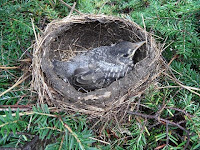 This morning while leaving for work, I spotted the female Ruby -throated Hummingbird again at my feeder. I have been a bit perplexed on why I don't see the male and why only one bird.
This morning while leaving for work, I spotted the female Ruby -throated Hummingbird again at my feeder. I have been a bit perplexed on why I don't see the male and why only one bird. This prompted me to do some research on the Hummingbird. I found these facts very interesting.
This hummingbird breeds in eastern North America and is the only hummingbird species to do so. Males establish a territory and court females who enter it with flying and diving behaviors, and by showing off their red throat plumage. Females provide all care for young hummingbirds. They lay one to three eggs, incubate them for about two weeks, and, after hatching, feed their young for about three weeks. A female may have several broods in a year. Ruby-throated hummingbirds are largely solitary outside of the breeding season. So, according to these facts, they are solitary birds which explains why we only see one at a time. For a short period immediately after fledging, a female will tolerate the presence of her own young at the feeder, but they are soon treated the same as other adult birds - as rivals in pursuit of the food necessary to prepare for the fall migration.
Also, the Male Ruby-throated Hummingbirds don’t stick around long. Pairs are together long enough for courtship and mating – just a matter of days to weeks. Then he’s off on his own, and may begin migration by early August. The Male is such a beautiful bird, so I am sorry he is a delinquent father, but we are grateful to have our one Hummingbird frequent out feeder.




































